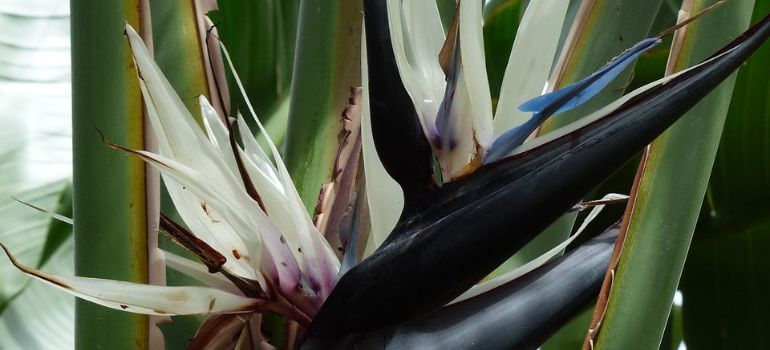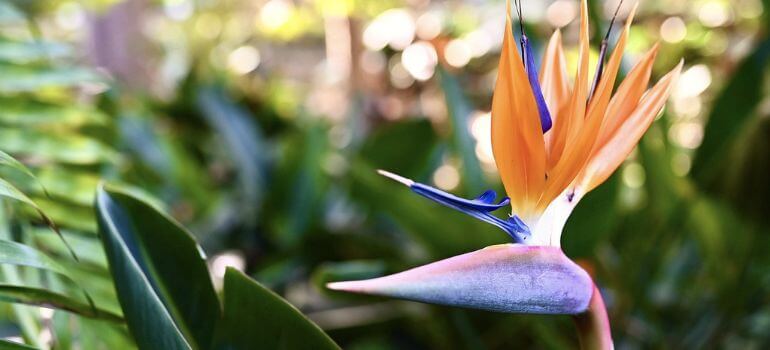Introduction
Bird of paradise plants, with their stunning, vibrant blooms, have become a favorite choice for gardeners and landscapers alike. The decision between the white and orange varieties, however, can be perplexing. In this article, we’ll explore the characteristics, care requirements, and aesthetic differences between white and orange bird of paradise, helping you make an informed decision for your garden.
White Bird of Paradise
Description and Characteristics
The white bird of paradise (Strelitzia nicolai) is known for its large, paddle-shaped leaves and elegant, white flowers. With a height that can reach up to 20 feet, this variety creates a striking tropical focal point in any landscape.
Ideal Growing Conditions
White bird of paradise thrives in tropical climates, requiring well-draining soil and ample sunlight. Its adaptability to different soil types makes it a versatile choice for various garden settings.
Popular Uses in Landscaping
Due to its size and visual impact, white bird of paradise is often used as a standalone specimen plant or as part of a lush tropical garden. Its architectural form adds a touch of sophistication to both residential and commercial landscapes.
Orange Bird of Paradise
Distinct Features and Appearance
The orange bird of paradise (Strelitzia reginae), also known as the crane flower, features banana-shaped leaves and vibrant orange and blue flowers. This compact variety is more suitable for smaller spaces.
Growing Requirements and Care Tips
Orange bird of paradise prefers well-drained soil and benefits from regular watering. While it can tolerate partial shade, it thrives in full sunlight. Its manageable size makes it a popular choice for container gardening and smaller outdoor spaces.
Applications in Garden Design
The vibrant colors of the orange bird of paradise make it a perfect choice for adding pops of color to gardens. It works well in mixed plantings and complements a variety of other tropical plants.
Comparing White and Orange Bird of Paradise

Aesthetics and Visual Appeal
The choice between white and orange bird of paradise often comes down to personal preference. The white variety exudes a sense of purity and elegance, while the orange variety adds warmth and tropical flair to the landscape.
Maintenance and Ease of Care
In terms of care, both varieties are relatively low-maintenance. However, white bird of paradise’s larger size may require more space, while the compact nature of the orange bird of paradise makes it easier to integrate into smaller gardens.
Suitability for Different Environments
Consider your local climate and available space when choosing between the two varieties. White bird of paradise is well-suited to larger, open landscapes, while the orange variety is a versatile option for urban gardens and compact areas.
Factors to Consider When Choosing
Climate and Weather Considerations
Before making a decision, assess your local climate. While both varieties can tolerate heat, white bird of paradise is more resilient in tropical conditions, whereas the orange variety can withstand milder climates.
Space and Landscape Design
Evaluate the available space in your garden and the overall design. White bird of paradise’s height and grandeur may be better suited for expansive yards, while the orange variety can thrive in both large and small settings.
Personal Preferences and Lifestyle
Consider your personal preferences and lifestyle when choosing between white and orange bird of paradise. The aesthetic you’re drawn to and the level of maintenance you’re willing to commit to should align with your gardening goals.
Tips for Cultivating Bird of Paradise Plants
Soil Requirements
Both white and orange bird of paradise plants prefer well-draining soil. Amend the soil with organic matter to ensure good drainage and provide essential nutrients for healthy growth.
Watering Guidelines
While bird of paradise plants are relatively drought-tolerant, consistent watering is crucial, especially during the growing season. Allow the soil to dry out between waterings to prevent root rot.
Pruning and Maintenance Tips
Regular pruning helps maintain the desired shape and size of your bird of paradise plants. Remove dead or damaged leaves and spent flower stems to encourage new growth and overall plant health.
Common Issues and Troubleshooting
Pest Control for Bird of Paradise Plants
Keep an eye out for common pests such as aphids and spider mites. Insecticidal soap or neem oil can be effective, providing a natural and safe solution for pest control.
Recognizing and Treating Diseases
Bird of paradise plants can be susceptible to fungal diseases, especially in humid climates. Proper ventilation, well-spaced plantings, and fungicidal treatments can help prevent and address these issues.
General Troubleshooting Advice
If your bird of paradise is not thriving, consider factors like sunlight, water, and soil conditions. Adjustments to these elements can often revive a struggling plant.
Success Stories and Testimonials
Gardeners around the world have shared their success stories with bird of paradise cultivation. From transforming barren corners into tropical paradises to creating stunning focal points in urban gardens, these testimonials inspire others to embark on their bird of paradise journey.
Bird of Paradise Varieties Beyond White and Orange
While white and orange bird of paradise are popular choices, there are lesser-known varieties worth exploring. Varieties like the giant bird of paradise (Strelitzia nicolai ‘Gigantea’) and the Mandela’s Gold bird of paradise (Strelitzia reginae ‘Mandela’s Gold’) offer unique features and colors.
Sustainability and Eco-Friendly Practices
Embrace eco-conscious gardening practices to minimize the environmental impact of bird of paradise cultivation. Consider using organic fertilizers, collecting rainwater for irrigation, and implementing sustainable pest control methods.
The Growing Popularity of Bird of Paradise Plants
Social media platforms are abuzz with bird of paradise enthusiasts sharing their #BirdOfParadiseJungle and #TropicalGarden transformations. Influencers showcase creative ways to incorporate bird of paradise into interior design, and DIY projects abound for those looking to propagate their plants.
Bird of Paradise in Art and Culture
The bird of paradise has not only captivated gardeners but also inspired artists and writers. From intricate botanical illustrations to its symbolic representation in various cultures, the bird of paradise holds a special place in the world of art and creativity.
Addressing Common Misconceptions
As with any popular plant, bird of paradise comes with its fair share of myths. From the belief that they need constant direct sunlight to misconceptions about their water requirements, it’s essential to separate fact from fiction for successful cultivation.
Conclusion
In the delightful dilemma of choosing between white and orange bird of paradise, the key is understanding your preferences and gardening conditions. Whether you opt for the purity of white or the vibrancy of orange, bird of paradise plants are sure to bring tropical splendor to your outdoor space. Join the growing community of bird of paradise enthusiasts and let your garden flourish with these captivating plants.
FAQs
Yes, bird of paradise plants can thrive indoors if provided with adequate sunlight and proper care. Consider placing them near a sunny window and ensure well-draining soil.
Watering frequency depends on factors like climate and soil conditions. In general, allow the soil to dry out between waterings, and water more frequently during the growing season.
While bird of paradise plants are not toxic to pets, it’s advisable to keep them out of reach as ingesting plant material can cause mild gastrointestinal upset.
Yes, combining white and orange bird of paradise can create a visually stunning and diverse garden. Ensure they have adequate space to grow without crowding each other.
With proper care, bird of paradise plants can live for several decades. Regular maintenance, including pruning and addressing pest issues, contributes to their longevity.



